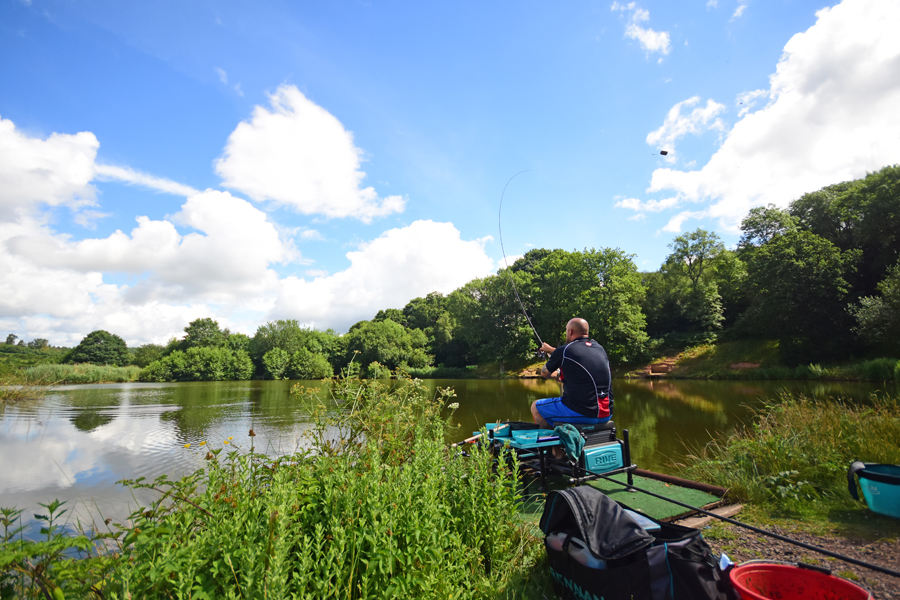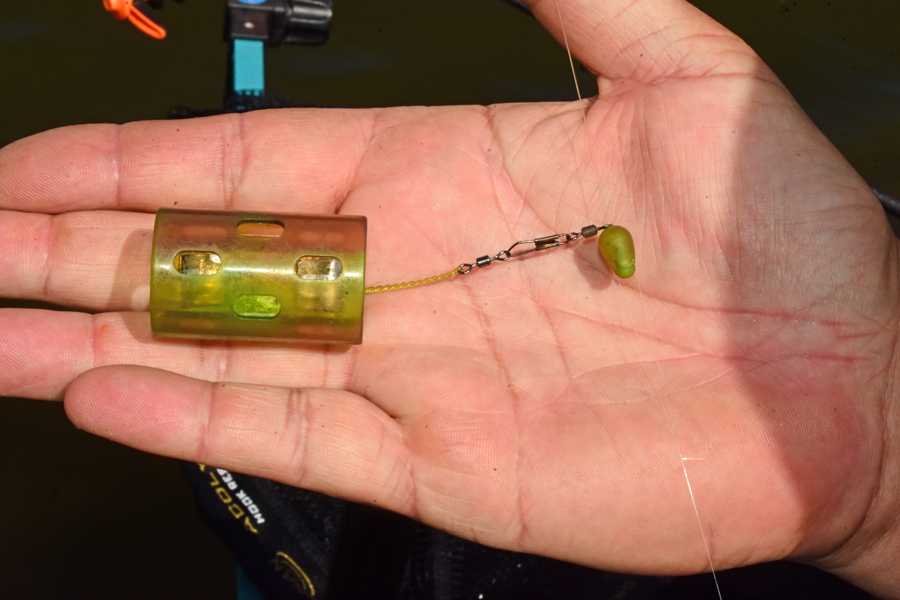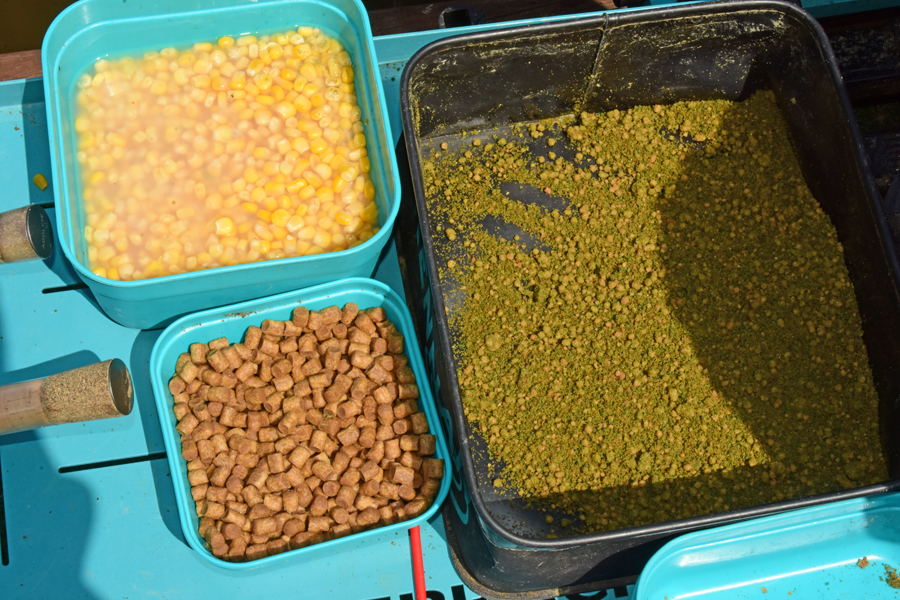25 Settembre, 2017 | Pesca al Colpo | Consigli | Articoli | Notizia
0 CommentiFeeder fishing is one of those tactics that everyone thinks is ‘easy’ to do. And it is, as long as you do it right.
There is a lot more to getting the most out of feeder fishing than simply mixing up any old groundbait, filling the first feeder you come to in your box and splodging it out into the swim.
Like any angling discipline, there is a real art to feeder fishing. And if you can get it right, you can really fill your boots – or your keep net!
I’m not really sure why the feeder ‘floats my boat’ so much over, say float fishing, but I just find it a very pleasant and pleasurable way to fish.
Plus, as the owner of Shatterford Lakes, I very often see first-hand the type of basic mistakes many anglers make.
To help people put these mistakes right, I’ve set myself up on Erics lake to demonstrate some of my tactical feeder tricks.
For the love of feeders
When it comes to angling, my first love is and always has been feeder fishing.
I find there is a real satisfaction to be had from selecting and then building a swim throughout the day. Being able to see your efforts come to fruition over the course of the session. It is also extremely effective when targeting both small and large fish.
With the feeder, once you get the fish going you can almost line them up, so you get a bite a chuck.
Done badly though and you will sink without trace. That’s probably what I find so fascinating about the tactic?
The one downside of feeder fishing though is it is fished static and hard on the deck. When faced with a very deep lake, like the ones here at Shatterford, this can cause problems, but I have a way to get around this.
With feeder fishing, like all angling, it’s the little things that will make the biggest difference.
All feeders are not the same
Like floats, there is a reason that feeders come in a huge range of shapes, styles, sizes and weights.
Probably the most popular on stillwaters is the cage feeder. Here at Shatterford though, these would be next to useless as they are really designed for fishing in shallow water – four-feet of less.
Cages are great to fill up quickly, but they are also designed to empty quickly too as the water can penetrate the payload much quicker.
Today I’m faced with a depth of close to 25-feet, so my first choice is an open-ended model. This allows me to fish pure groundbait, or sandwich various loosefeed items in the middle. Being enclosed I can affect the breakdown rate of the payload, depending upon how firmly I press the crumb into the feeder also.
Regards weights and sizes, this again needs careful consideration.
For my session on Erics, I’ve selected a Standard XL 30g Drennan feeder. The reason being there are a lot of very large fish – both carp and silverfish – as well as good numbers of them, so I want to put plenty of loosefeed out, to hold the fish in the swim.
A 30g version is so the feeder sinks quickly so the payload breaks down on the lakebed, not on the way down.
It is possible to get a feeder the same size that only carries 16g, or a much smaller feeder that is the same weight.
But, like float choice, it is all about what you’re planning to do and how you are looking to fish on the day.
The rule of thumb I like to work to is size is dictated by the number of fish you’re likely to encounter compared to the quantity of loosefeed you are planning to introduce.
The weight side of things depends upon the depth of the lake and/or the distance you are looking to cast. The greater either or both are, the heavier you should go.
There is one occasion that a small, but heavy feeder will work better though in very shallow water and that is when you are fishing into the margins of an island.
Being a prominent feature, fish are normally here, so don’t need a huge amount of feed to hold. But, if the slope is very steep, you’ll need possibly 30g or more so that the rig holds. Again, every day is different. Don’t make your selection until you know exactly what you are faced with.
The day’s set-up
Unless dictated by fishery rules, I’m a real fan of fixing my feeders in a small six-inch loop when targeting silverfish or big bream. The loop acts like a slammer rig, meaning they only feel the full weight after they have moved off with the hookbait.
For carp though, it is a simple free-running set-up, as their takes tend to be much more savage.
The mainline I select is 8lb. This may sound very heavy for silverfish, but a loaded feeder can weigh in excess of two-ounces, which can put a real strain on your tackle, especially when casting every five-minutes.
The same goes for the hooklink. I’ll use an 18-inch length of 0.17mm (4lb 4oz) fluorocarbon to a size 18 eyed hook. As everything is presented on the deck, it allows you to use more robust end tackle.
I generally start with an 18-inch hooklink as it allows the hookbait to gently flutter down through the final layers of the swim.
If I’m getting sucked maggots or skinned corn and not seeing the bites, I’ll shorten up by six-inches until I do see them. Conversely, if I’m struggling I will lengthen the hooklink by six-inches every 15-minutes until I do get bites – to a maximum of three-feet normally.
Bait choice
As today was all about targeting the big bream, I’ve loaded the side tray with a range of simple fare.
The groundbait is a 50:50 mixture of Dynamite Baits’ Green Swim Stim and Swim Stim Milled Expanders Amino Original.
To give these ‘eating machines’ something to hold them I also add a generous quantity of both 1mm Amino Original Swim Stim Carp Pellets and 2mm XL Pellets.
For the hook, I’ll either ‘match the hatch’, with a hard 8mm pellet or a hi-viz offering of hair-rigged sweetcorn. Using an open-ended feeder means I can introduce a few hookbait offerings every cast or so, depending upon the amount of bites I’m getting.
The feeder is then cast every five minutes at least, to put a good bed down and help draw and hold some slabs.
Up they come…
The one downside of the feeder is that everything is on the deck. This can be a real problem on deep lakes, as the fish will naturally come up in the water as the session continues.
You will find when this happens that you’re getting rattles on the tip as the feeder enters the water, then no action once the rig has sunk past where they are sitting and when it eventually settles
The way around this is to set-up a waggler rig.
It can be a large peacock or even a pellet waggler, just as long as you can cast it to the exact same area the feeder is landing.
Using the same groundbait mix, I fire small balls around the float, to imitate the feeder landing. If the fish have come up in the water, you will now be able to catch them.
When firing in groundbait balls, some feed will still get the bottom, so again, if the float bites dry up, I can swap back onto the feeder to see if they have followed the bait down.
You need to be careful that you don’t make the balls too hard though, as they will sink intact rather than breaking up in the upper layers.
Conversely, if they are too soft, you won’t be able to catapult them. It’s a bit of a balancing act and something that requires a little practice.
Like the feeder, I look to feed a ball a cast. Then it is just a case of following the fish up and down throughout the day, depending upon the signs/bites you’re experiencing.
As the sun is very strong today and the water warm, the fish have come up rather quickly.
I ended up spending around an hour or so on the bottom, before I started to get knocks on the rod tip soon after the feeder entered the water. This indicated that the fish were in the top three to four feet.
Swapping onto the waggler line and small groundbait ball tactics, I was able to keep the bites coming.
By the end of the session, I had accumulated well over 100lb of fine slab-sided bream, around 50 per cent caught traditionally, using feeder tactics, the rest coming to the waggler, fished shallow, on the same line.
As with any method, you’ll only get out what you put in.
If you’re only prepared to cast out every half-hour, using an inappropriate feeder and the wrong groundbait mix, you may take a lucky fish or two.
But, if you choose the right baits, set-up and approach, you will soon be replicating catches like this.
Your only problem now is, you might need to take a mate along, to help you lift out your keep net at the end of the day!
Grant Albutt





























Nessun commento, inizia la conversazione